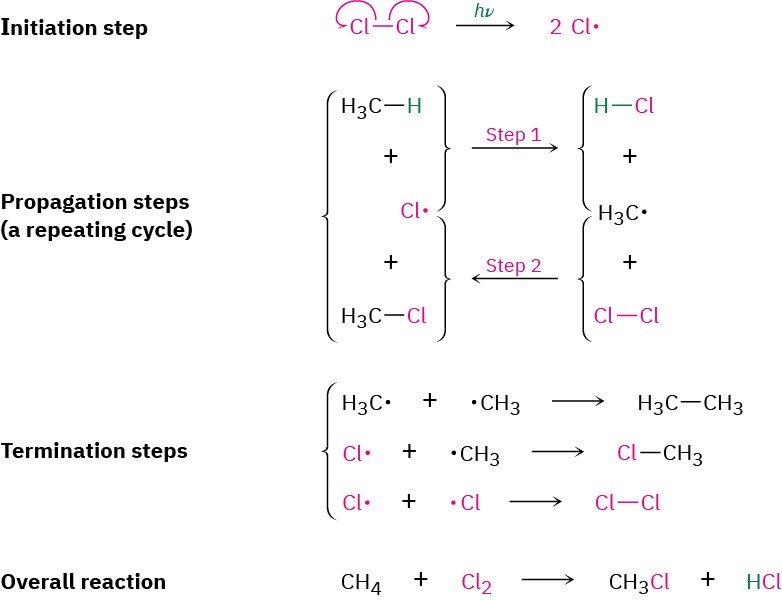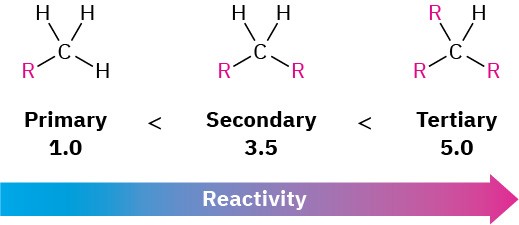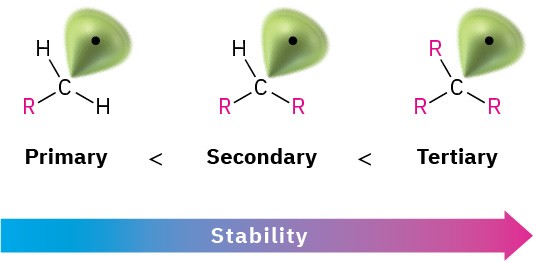10.2 Preparing Alkyl Halides from Alkanes: Radical Halogenation
As we saw briefly in Section 6.6, simple alkyl halides can sometimes be prepared by the radical reaction of an alkane with Cl2 or Br2 in the presence of ultraviolet light. The detailed mechanism is shown in Figure 10.2 for chlorination.

Figure 10.2 Mechanism of the radical chlorination of methane. Three kinds of steps are required in radical substitution reactions: initiation, propagation, and termination. The propagation steps are a repeating cycle, with Cl· a reactant in step 1 and a product in step 2, and with ·CH3 a product in step 1 and a reactant in step 2. The symbol hν shown in the initiation step is the standard way of indicating irradiation with light (ν is the lowercase Greek letter nu).
Radical substitution reactions require three kinds of steps: initiation, propagation, and termination. Once an initiation step has started the process by producing radicals, the reaction continues in a self-sustaining cycle. The cycle requires two repeating propagation steps in which a radical, the halogen, and the alkane yield alkyl halide product plus more radical to carry on the chain. The chain is occasionally terminated by the combination of two radicals.
Unfortunately, alkane halogenation is a poor synthetic method for preparing alkyl halides because mixtures of products invariably result. For example, chlorination of methane does not stop cleanly at the monochlorinated stage but continues to give a mixture of dichloro, trichloro, and even tetrachloro products.

The situation is even worse for chlorination of alkanes that have more than one kind of hydrogen. Chlorination of butane, for instance, gives two monochlorinated products in a 30 : 70 ratio in addition to multiply chlorinated products such as dichlorobutane, trichlorobutane, and so on.

As another example, 2-methylpropane yields 2-chloro-2-methylpropane and 1-chloro-2- methylpropane in a 35 : 65 ratio, along with more highly chlorinated products.

From these and similar reactions, it’s possible to calculate a reactivity order toward chlorination for different kinds of hydrogen atoms in a molecule. Take the butane chlorination, for instance. Butane has six equivalent primary hydrogens (−CH3) and four equivalent secondary hydrogens (−CH2−). The fact that butane yields 30% of 1- chlorobutane product means that each one of the six primary hydrogens is responsible for 30% ÷ 6 = 5% of the product. Similarly, the fact that 70% of 2-chlorobutane is formed means that each of the four secondary hydrogens is responsible for 70% ÷ 4 = 17.5% of the product. Thus, a secondary hydrogen reacts 17.5% ÷ 5% = 3.5 times as often as a primary hydrogen.
A similar calculation for the chlorination of 2-methylpropane indicates that each of the nine primary hydrogens accounts for 65% ÷ 9 = 7.2% of the product, while the single tertiary hydrogen (R3CH) accounts for 35% of the product. Thus, a tertiary hydrogen is 35% ÷ 7.2%
= 5 times as reactive as a primary hydrogen toward chlorination.

The observed reactivity order of alkane hydrogens toward radical chlorination can be explained by looking at the bond dissociation energies given previously in Table 6.3. The data show that a tertiary C−H bond (400 kJ/mol; 96 kcal/mol) is weaker than a secondary C−H bond (410 kJ/mol; 98 kcal/mol), which is in turn weaker than a primary C−H bond (421 kJ/mol; 101 kcal/mol). Since less energy is needed to break a tertiary C−H bond than to break a primary or secondary C−H bond, the resultant tertiary radical is more stable than a primary or secondary radical.

Problem 10-3
Draw and name all monochloro products you would expect to obtain from radical chlorination of 2-methylpentane. Which, if any, are chiral?
Problem 10-4
Taking the relative reactivities of 1°, 2°, and 3° hydrogen atoms into account, what product(s) would you expect to obtain from monochlorination of 2-methylbutane? What would the approximate percentage of each product be? (Don’t forget to take into account the number of each kind of hydrogen.)

